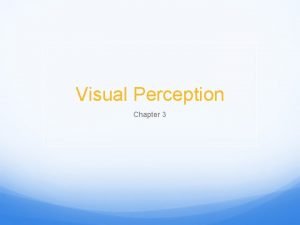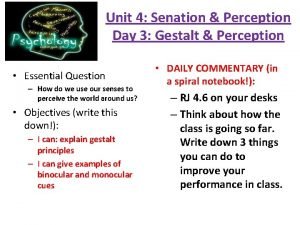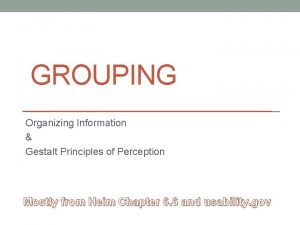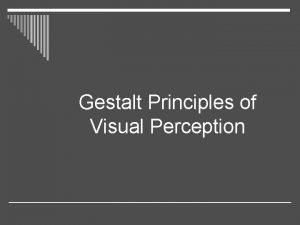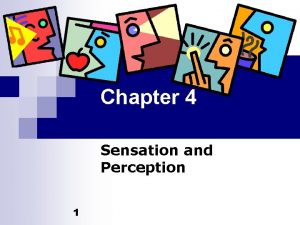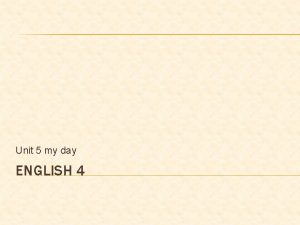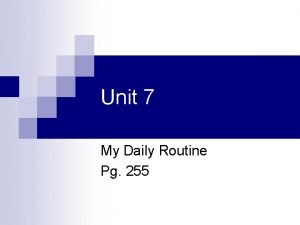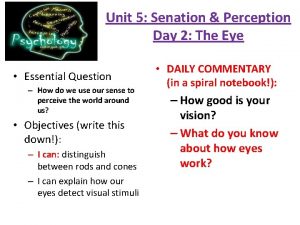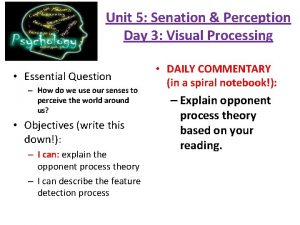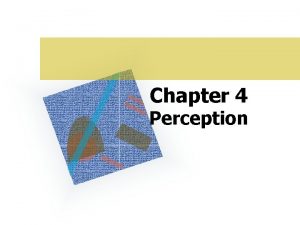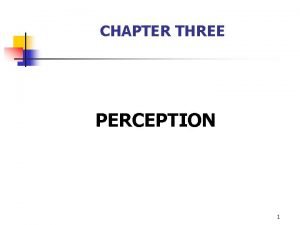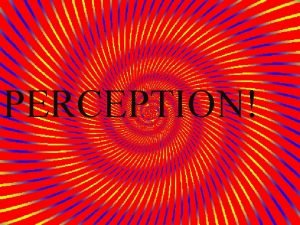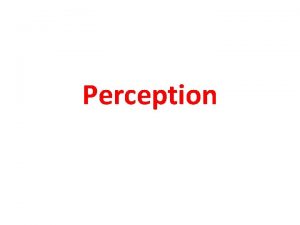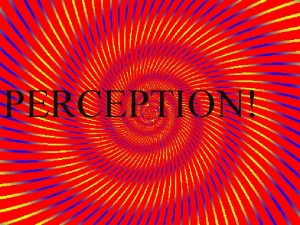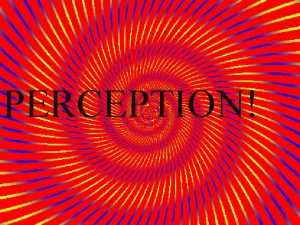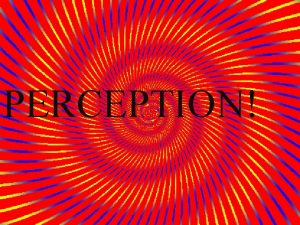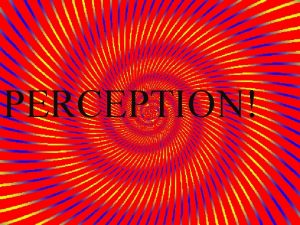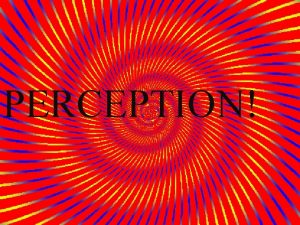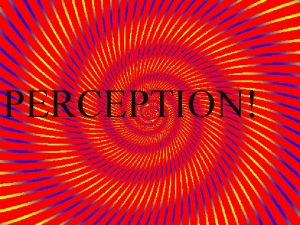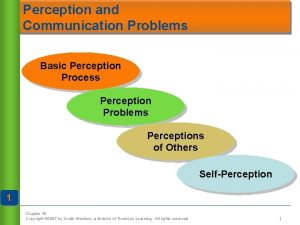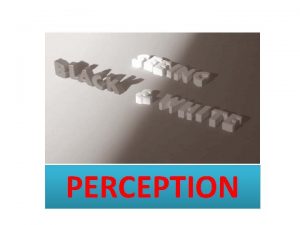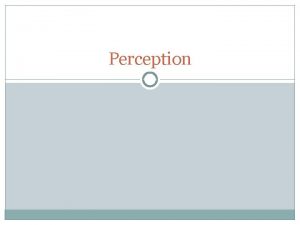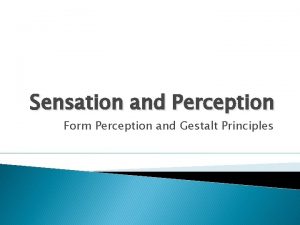Unit 4 Senation Perception Day 1 Principles of
























- Slides: 24

Unit 4: Senation & Perception Day 1: Principles of Sensation • Essential Question – How do we use our senses to perceive the world around us? • Learning Goals: – I can: distinguish between top down and bottom up processing – I can generate examples that demonstrate signal detection theory • WARM UP (on my signal): – Glance for 1 second at spot in the room and then immediately look away. • Write down everything you recall seeing.

Unit 4: Senation & Perception Day 1: Principles of Sensation • Today: – DC – Discussion of Midterm & Review plan – Unit Overview – Notes – Overview of Unit Project – Review Activity • Concept Mapping • Your Midterm: – January 14 th • Owe end of quarter projects: – Brody, Dani, & Daisy – Samantha & Karla • Due Wednesday (these were assigned over the break): – RJ 7. 1 & RJ 7. 2 (Sensation Theory) • Myers 197 -203 / Griggs 77 -84 – RJ 7. 3 & 7. 4 (The Eye) • Myers 204 -214 / Griggs 87 -92

watch carefully & remember what you see 8 ZQ 4 F 0 9 r wild W 7

Sensation & Perception How do we construct our representations of the external world? To represent the world, we must detect physical energy (a stimulus) from the environment and convert it into neural signals. This is a process called sensation. When we select, organize, and interpret our sensations, the process is called perception. 4

So…. • Sensation – detecting what is around us & sending that information to the brain • Perception – making sense of what we sense

Top-Down Processing: PERCEPTION Information processing guided by higher-level mental processes as we construct perceptions, drawing on our experience and expectations. THE CHT 6

Making Sense of Complexity Our sensory and perceptual processes work together to help us sort out complex images. “The Forest Has Eyes, ” Bev Doolittle 7

Today’s Focus: Exploring the Senses 1. What stimuli cross our threshold for conscious awareness? 2. Could we be influenced by stimuli too weak (subliminal) to be perceived? 3. Why are we unaware of unchanging stimuli, like a band-aid on our skin? 8

Thresholds Proportion of “Yes” Responses 0. 00 0. 50 1. 00 Absolute Threshold: Minimum stimulation needed to detect a particular stimulus 50% of the time. 0 5 10 15 20 Stimulus Intensity (lumens) 25 9

Detection Absolute Threshold Intensity No No No Yes Observer’s Response Detected Tell when you (the observer) detect the light. 10

Subliminal Threshold: When stimuli are below one’s absolute threshold for conscious awareness. Kurt Scholz/ Superstock 11

Are there Subliminal Messages in Songs? • http: //www. youtube. com/watch? v=xj 2 d. Js. Vpg CY • http: //www. youtube. com/watch? feature=end screen&NR=1&v=t. N 3 s. My. DCGO 4 12

I need a few volunteers Left Hand Right Hand • You will hold something in each hand. • Tell me whether one appears heavier than the other, or whether they appear to be the same weight. Examples of Just Noticeable Difference

Difference Threshold: Minimum difference between two stimuli required for detection 50% of the time, also called just noticeable difference (JND). Difference Threshold No No Yes Observer’s Response Tell when you (observer) detect a difference in the light. 14

Fetchner - Weber Law Two stimuli must differ by a constant minimum percentage (rather than a constant amount), to be perceived as different. Weber fraction: k = d. I/I. Stimulus Constant (k) Light 8% Weight 2% Tone 3% 15

Stevens’s Power Law • To perceive a stimulus (such as light) as twice as bright, it must increase in intensity by 8 to 9 times – Doubling the amount of light or volume will not result in our perceiving that it has in fact doubled

Signal Detection Theory (SDT) Predicts how and when we detect the presence of a faint stimulus (signal) amid background noise (other stimulation). SDT assumes that there is no single absolute threshold and detection depends on: Carol Lee/ Tony Stone Images Level of fatigue Expectations Motivation Person’s experience 17

SDT Matrix The observer decides whether she hears the tone or not, based on the signal being present or not. This translates into four outcomes. Decision Yes No Present Hit Miss Absent False Alarm Correct Rejection Signal 18

Quick Write – in Google Classroom • Based on your understanding of the lesson so far: – Use signal detection theory to explain why the idea of “absolute threshold” has limited value.

Psychophysics A study of the relationship between physical characteristics of stimuli and our psychological experience with them. Physical World Psychological Experience Light Brightness Sound Volume Pressure Weight Sugar Sweetness 20

Sensory Adaptation Diminished sensitivity as a consequence of constant stimulation. Put a band aid on your arm and after awhile you don’t sense it. 21

So…we have a benchmark coming up • • Unit 1 – Research Unit 2 – Developmental Psych Unit 3 – Biological Bases of Behavior Unit 4 – Sensation & Perception • Go to Quizlet, we’ll practice a bit


Now you see, now you don’t 24
 Day 1 day 2 day 3 day 4
Day 1 day 2 day 3 day 4 Day 1 day 2 day 817
Day 1 day 2 day 817 Gestalt principles of visual perception
Gestalt principles of visual perception Sensation
Sensation Convergence gestalt
Convergence gestalt Perception gestalt principles
Perception gestalt principles Gestalt
Gestalt Perception gestalt principles
Perception gestalt principles Unit 10, unit 10 review tests, unit 10 general test
Unit 10, unit 10 review tests, unit 10 general test William beanes elementary
William beanes elementary Ocean the part day after day
Ocean the part day after day Day to day maintenance
Day to day maintenance As your room gets messier day by day, entropy is
As your room gets messier day by day, entropy is I don't know about tomorrow
I don't know about tomorrow Romeo and juliet day timeline
Romeo and juliet day timeline Growing day by day
Growing day by day Define seed dormancy
Define seed dormancy Germination conclusion
Germination conclusion Observation of plant growth day by day
Observation of plant growth day by day I live for jesus day after day
I live for jesus day after day One day he's coming oh glorious day
One day he's coming oh glorious day Day one day one noodle ss2
Day one day one noodle ss2 Dayone dayone noodles ss2
Dayone dayone noodles ss2 Unit 5 my day off
Unit 5 my day off Unit 7
Unit 7



